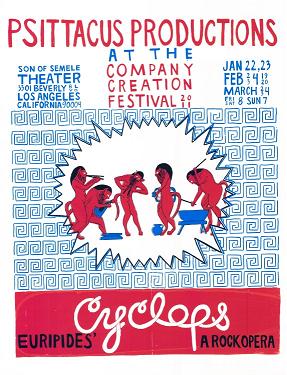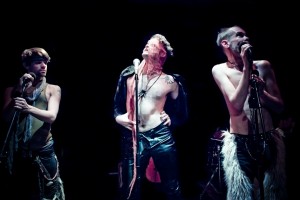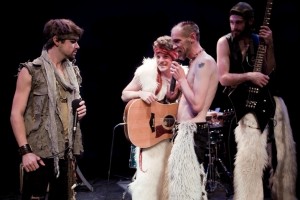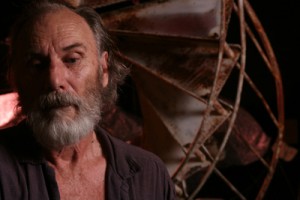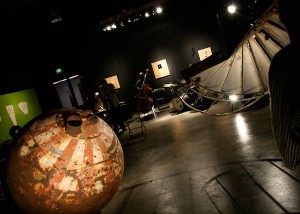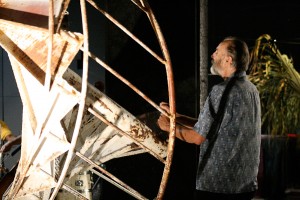MAKE NOISE: ARTISTS AT WORK
There is nothing more liberating than going to the theater in complete ignorance of what one is going to see. If context is everything, then it is no accident that this is exactly what this reviewer experienced just last weekend on two consecutive nights. The results couldn’t be more joyous. There are serious artists at work. And they are as playful as otters.
I had never read Euripides’s satyr play Cyclops nor had I read the Percy Bysshe Shelley translation when I came to see the Psittacus Production of Cyclops: A Rock Opera; I had no idea of what to expect, except that I so thoroughly enjoyed their last theatrical offering A Tale Told By An Idiot and was hoping that they would at least duplicate the success of that theatrical offering. The gang of actors had become a gang of rock musicians, calling themselves, appropriately enough, The Satyrs, and, within minutes, the talent and energy they exuded had the bracing effect of transporting me back to New York’s East Village in the late 70s and early 80s when you could go to a club like The Pyramid or 8BC and come across the most unlikely performers doing the most unlikely things, stuff that was both serious and fun, reverent and irreverant, old and new. I am talking about a certain spirit; Cyclops was decidedly fresh and innovative stuff and in no ways imitative.
As the band played, tableaux vivants of Guy Maddin-like imagery – of Dionysus and his hand maidens, the Maenad – were struck. As the music shifted gears, so would the images. And, somehow, a sense of poetry was created just by this simple juxtaposition. And slowly but very surely the musicians became the characters Euripedes created and were then transformed by their terrific vocal abilities. There was just enough text – and enough playful variations on the text – to tell us we were being guided through the evening by the substance of the play just as we were being taken in totally different directions by its style. So it was both a rock concert and a rock opera and it was also a cannily conceived classic text, and, above all, it was marvelously entertaining. Did I understand it all, not having read any of the sources in advance? Not really, but, of course, it doesn’t matter. When you put yourself in the hands of such intelligent theater practitioners as the Psittacus group, the only thing you can count on is that you can’t count on anything. The one thing that you can count on is this: in proper Dionysian fashion, this was an evening in which the most cheerfully leering and obscene merriment was being outrageously and niftily celebrated by an extravagantly talented theater company.
Nor had I ever heard of George Herms before I saw George Herms: The Artist’s Life. In all the literature I’ve read about the Beats, Herms’s name was not familiar. And I could only guess at what funk assemblage – Herms’s art form – might be. But, while foreknowledge may have been the spur that drove his admirers to catch his show at the REDCAT, none of that really mattered. What did matter was what was on the stage: a loose and casually playful demonstration of the evening’s title. Here was an artist sharing his art and his joie de vivre as well as the art of the truly exceptional musicians – the Bobby Bradford Mo’tet and the Theo Saunders Group – he has gathered together. And he counts among his friends a singer, Diana Briscoe, whose octave range is almost as interesting as what she is capable of doing with it vocally. In fact, this may be the first time in the history of music (and certainly in the theater) that a singer sang a duet with a piece of sculpture. A rusting spiral staircase, possibly retrieved from a dumpster, is suspended, becoming a free-floating sculpture which constantly revolves around Ms. Briscoe as she goes through a charming and jazzily eccentric aria; she is sometimes obscured by the sculpture in its revolutions, sometimes totally visible, the pattern changing and accelerating with each turn of the spiral staircase. It was something to hear. And see.
But the real miracle of the evening is Herms himself. At 75, his seismic energy would inspire not only his fellow septuagenarians but almost anyone. What he does with the slats of Venetian blinds is dizzying. And his dancing, while toting a step-ladder sculpture wrapped around him, is, in essence, a dance of life and, by extension, a dance of death. But one needn’t worry. Herms defies death. He’s having too much fun living. And, anyway, in defying death, he makes an ascension which practically canonizes the artist.
Now, what are the odds of seeing levitation on a stage more than once in a lifetime? It is interesting to me that, in a mere two weeks, there have been three theater events in town which move towards floating upwards as a final act of independence. Herms does it best. He makes you feel as if you can do it yourself. George Herms: The Artist’s Life starts with the curtain call and ends at a beginning and reminds you that, ultimately, it is To Be Continued. Isn’t that what you would expect the credo of an artist to be?
Moral: When artists are at work, the less you know, the more liberating it is, because it allows you to be in on the mysteries and the illuminations as they occur.
Herms photos courtesy of the artist
Cyclops photos by Wenona Cole-Mclaughlin
Cyclops: A Rock Opera
Son of Semele Ensemble, 3301 Beverly Blvd.
Fri & Sat at 8; Sun at 7
ends on March 20, 2011
for tickets, visit Psittacus or SOSE
George Herms: The Artist’s Life
REDCAT, 631 W. 2nd St.
ends on February 5, 2011
for tickets, visit REDCAT
